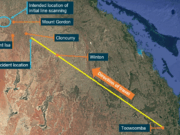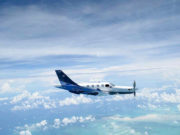An improperly adjusted safety switch that rendered the aircraft’s pressurization system inoperative, an incorrectly wired cabin altitude warning switch that disabled a warning light and the pilot’s ineffective systems monitoring while distracted by an autopilot problem early in the flight were among the factors that led to a dangerous encounter with hypoxia, according to the Australian Transport Safety Bureau (ATSB).
Starved of oxygen during the climb to cruise altitude, the pilot’s mental functioning deteriorated to the point where he could not resolve a troubling indication on the Beech King Air C90’s cabin altimeter. As confusion mounted, he fixated on a navigation readout that he incorrectly interpreted as an indication of an unusually low groundspeed.
That mistake, however, actually saved the day: Descending to escape the perceived gale of a head wind, the pilot entered a more oxygen-rich environment, where his brain eventually began to work again.
“Had the pilot continued at cruise altitude for an extended length of time, it is probable that he and the passenger would have lapsed into an unconscious state, from which neither may have recovered,” the ATSB report said.
The July 16, 2009, incident was cited by ATSB as yet another example of the insidious nature of hypoxia and why all pressurized, turbine aircraft certified for single-pilot operation should provide aural as well as visual warnings of cabin pressurization problems.
‘Pretty Busy’
The incident occurred during a charter flight in Western Australia — from Perth to Wiluna, about 390 nm (722 km) northeast.
The pilot held a commercial license and a command multiengine instrument rating. He had 3,140 flight hours, including 2,619 hours as pilot-in-command. “He had a total of 470 hours’ flight experience in turboprop aircraft, of which 80 hours were on the King Air C90 aircraft type,” the report said, noting that he recently had completed a check flight in a Beech 1900D. His age was not specified.
The aircraft, VH-TAM, departed from Perth at 1026 local time. “The weather for the departure and climb to the planned cruise altitude of Flight Level (FL) 210 indicated instrument meteorological conditions with moderate turbulence, rain and cloud,” the report said.
The pilot told investigators that he checked the pressurization system twice during the climb, at 6,000 ft and at 10,000 ft, the transition altitude. The checks typically encompass three devices mounted on the King Air’s center pedestal: the pressurization system controller, which is used to set the desired cabin altitude and cabin rate of climb; the cabin rate-of-climb indicator; and the cabin altimeter, which shows the differential between external atmospheric pressure and cabin pressure, as well as the cabin altitude.
The report provided no details about the check at 6,000 ft. It said that the pilot recalled seeing 300 fpm on the cabin rate-of-climb indicator but did not remember checking the controller or cabin altimeter while climbing through 10,000 ft.
“The pilot indicated that during the transition checks, he was ‘pretty busy,’ as the aircraft was encountering rough weather with moderate turbulence,” the report said. “He was also having difficulties with the aircraft’s autopilot at that time.”
‘Unable to Reason’
Recorded air traffic control (ATC) radar data showed that the King Air reached FL 210 about 18 minutes after departing from Perth. “The pilot reported that the autopilot difficulties continued once at FL 210, with the system taking several minutes to engage the altitude-hold function,” the report said.
The pilot also told investigators he noticed that the cabin altimeter was indicating 20,000 ft. “He recalled feeling some concern at this but at the time being unable to reason what to do to alleviate that concern,” the report said.
If the pressurization system had been set properly and was functioning properly, the indicated cabin altitude at FL 210 should have been about 8,000 ft. An indication of 20,000 ft meant that the cabin was not pressurized.
The pilot also recalled that while reprogramming the global positioning system (GPS) receiver in response to an amended route clearance from ATC, he became “fixated” on a GPS readout that he thought was a groundspeed indication.
He actually was looking at a distance-remaining indication. The report did not specify the figure, but it apparently was low enough to cause the pilot to perceive that the aircraft had a 100-kt head wind. (The aircraft actually had a slight tail wind.)
“Consequently, the pilot contacted ATC, requesting a descent to FL 190 in an attempt to improve his groundspeed,” the report said. “That request was granted.”
The aircraft had been at FL 210 for 11 minutes when the pilot began the descent. “At 1107, about 10 minutes after becoming established at FL 190, the pilot queried ATC about the perceived strong head winds,” the report said. “ATC indicated that no one else had reported those winds.”
Shortly thereafter, the pilot requested and received clearance to descend to FL 140, which he subsequently amended to FL 150. The King Air reached that level at 1124, or 58 minutes after departing from Perth.
“The pilot clearly recalled seeing 15,000 ft on the outer scale of the [cabin] altimeter several times but noted that he was still unable to understand the reason for that reading,” the report said.
After about 30 minutes at FL 150, and about 80 nm (148 km) from the destination, the pilot realized that the King Air’s cabin was not pressurized and that he was experiencing hypoxia.
“The pilot immediately conducted a descent to below 10,000 ft, contacting ATC and indicating that he had left FL 150 on descent for Wiluna,” the report said. He subsequently landed the aircraft without further incident.
‘Hairline’ Switch
The safety switch, or squat switch, mounted on the King Air’s left landing gear strut is designed to be compressed when the gear is extended, causing the safety valve — a backup cabin pressurization outflow valve — to open fully, ensuring that the cabin is depressurized before landing. This function prevents structural damage that could occur if the aircraft is landed with the cabin still pressurized.
When the landing gear is retracted on takeoff, the safety switch extends and causes the safety outflow valve to close, enabling the cabin to pressurize by retaining in a controlled manner the conditioned bleed air supplied by the engines.
The safety switch on the incident aircraft was not adjusted correctly. “Maintenance personnel [who examined the switch said] that the adjustment was found to be on a ‘hairline’ setting, with the effect that the switch sometimes worked correctly and at other times did not,” the report said.
The switch apparently did not extend sufficiently to close the safety outflow valve on takeoff for the incident flight. Thus, although the cabin pressurization controller had been set correctly, the cabin did not pressurize, and the pilot did not detect the anomaly.
Crossed Connection
The “ALT WARN” annunciator light atop the instrument panel should have illuminated when the aircraft climbed above about 10,500 ft. The pilot recalled that the light had illuminated when he pushed the “PRESS TO TEST” button on the annunciator panel during his preflight preparations. The report noted, however, that this tests only the light bulbs; it reveals nothing about the status of the systems themselves.
In this case, the cabin altitude warning system was inoperative because its activating switch was miswired.
The switch had been replaced in December 2007, during routine maintenance that included a test of the cabin altitude warning system mandated by an airworthiness bulletin, ASW 21-1, issued by the Australian Civil Aviation Safety Authority (CASA) in 2002.
“The maintenance personnel indicated that the new switch was not tested prior to fitment, as its supporting documentation indicated that it was serviceable,” the report said.
The switch has three terminal posts, of which only two must be electrically connected to the warning system. One of the two wires had been connected to the wrong post on the old switch, rendering the warning system inoperable. Apparently not recognizing the error, the maintenance technicians had wired the new switch the same way; thus, the warning system remained inoperative.
Moreover, investigators found no record of compliance with an airworthiness bulletin requiring tests of the system every 12 months. “The [operator’s] maintenance control subcontractor indicated that the requirement … had inadvertently been omitted when setting up the aircraft’s maintenance database [after the King Air was registered in Australia in 2006],” the report said.
“That omission meant that a functional test of the aircraft cabin altitude warning system was not carried out on several occasions following the fitment of the replacement pressure switch.”
The report also noted that the preflight test of the pressurization system prescribed by the aircraft operating manual would not have revealed the problems with the cabin altitude warning switch or the landing gear safety switch.
Key to Survival
The report cited an ATSB study of aircraft depressurization accidents and incidents that showed that “there is a high chance of surviving a pressurization system failure, provided that the failure is recognized and the corresponding emergency procedures are carried out expeditiously.”1
Among the occurrences included in the study was a July 21, 1999, incident in which a King Air 200 pilot inadvertently turned the engine bleed air switches off while attempting to reposition the adjacent cabin vent blower switches from “HI” to “LOW” while conducting the transition checks.
He subsequently did not notice the “ALT WARN” light and lost consciousness during cruise flight at FL 250. The right-seat passenger, who was an experienced pilot but not type-rated in the 200, conducted an emergency descent. The pilot regained consciousness during the descent and subsequently landed the aircraft without further incident.
The ATSB’s investigation of the King Air 200 incident generated a recommendation in 2000 to require installation of aural cabin altitude warnings in King Airs and “other applicable aircraft.” Although CASA initially accepted the recommendation, it eventually chose to recommend, rather than require, installation of aural warning systems.
Noting that very few operators had voluntarily installed aural warning systems, ATSB reiterated the recommendation for mandatory installation during its investigation of the C90 incident.
“Although in this instance the cabin altitude warning system did not operate, numerous studies … have shown that when affected by hypoxia, human beings respond better to an audible warning [than to a visual warning],” the report said.
“Had the [incident] aircraft been fitted with an audible warning system … that operated independently of its visual system, it is likely that, even in the high workload at the time, the pilot would have been alerted to the pressurization event well before the onset of hypoxia.”
In response to the reiterated recommendation, CASA in October 2010 publicly proposed mandatory installation of aural cabin pressure warning systems in all single-pilot, turbine-powered, pressurized aircraft.
In June 2011, CASA told ATSB that it withdrew the proposal because it had met “negative response” by operators in Australia and had received no support from the U.S. Federal Aviation Administration.
The report said that although ATSB “can understand CASA’s and the industry’s preference to not mandate uniquely Australian requirements,” the bureau “remains concerned with the continuing incidence of serious incidents and fatal accidents in which the occupants of single-pilot, turbine-powered, pressurized aircraft have been affected by, or have succumbed to, unrecognized hypoxia in an unpressurized cabin.”
This article is based on ATSB Transport Safety Report AO-2009-044, “Air System Event, 74 km NE of Perth Airport, Western Australia, 16 July 2009, VH-TAM, Beechcraft King Air C90.” The report, issued in September 2011, is available at atsb.gov.au/publications/investigation_reports/2009/aair/ao-2009-044.aspx.
Note
- The study report, Depressurisation Accidents and Incidents Involving Australian Civil Aircraft 1 January 1975 to 31 March 2006, is available at atsb.gov.au/media/32876/b20060142.pdf.


